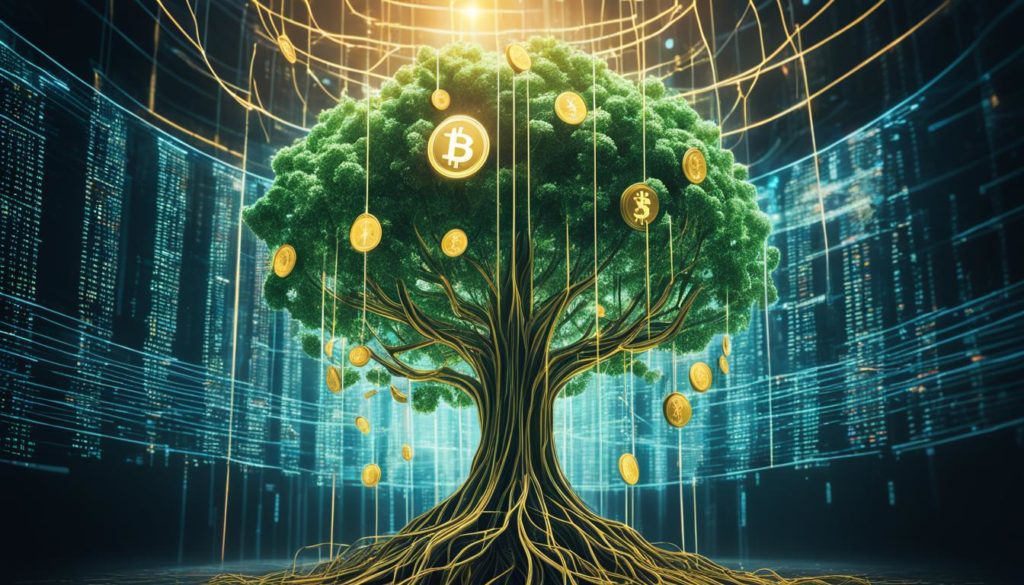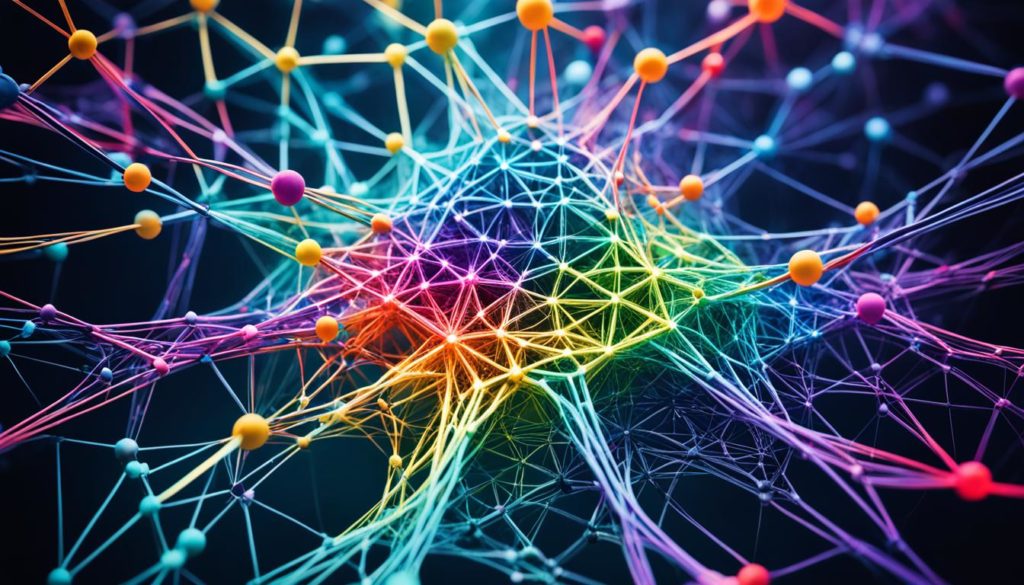
Did you know that McKinsey’s 2023 banking report found generative AI could boost productivity by up to 5%? It could also cut global costs by $300 billion. Artificial intelligence in finance is changing the game. It’s making banking more efficient and improving how we connect with clients.
Serge Beck, CEO of OmniWire, talks about AI’s big impact on banking. At first, AI was all about automating tasks and analyzing data. Now, it’s used for risk management, catching fraud, and giving customers personalized service. Generative AI is taking things to the next level with smarter banking tech.
Let’s explore how artificial intelligence is changing finance. It’s not just about making things run smoother. It’s also about making banking better for customers.
Key Takeaways
- Generative AI can boost banking productivity by up to 5%.
- Potential savings of $300 billion in global expenditures due to AI integration.
- Initial AI applications focused on automating workflows and data analysis.
- Current AI use extends to risk management and fraud detection.
- Personalized customer services are significantly improved through AI.
The Evolution of AI in Banking
The banking world is changing fast thanks to AI. From old AI to new generative AI, the change is big. Now, banks can better serve customers and work more efficiently.
The transition from classic AI to generative AI
Before, AI in banking was mainly about using data for security and risk. Now, with generative AI, things have changed a lot. Banks use machine learning to better understand what customers need and offer services that fit those needs.
Generative AI also lets banks create new products and services. This makes banking easier and more intuitive for customers.
Far-reaching implications for traditional banks and neobanks
Generative AI is changing the game for both old and new banks. It helps traditional banks and neobanks work better. Automated banking solutions make things run smoother, letting banks focus on what customers want.
Neobanks use machine learning to offer fast, personalized services. This gives them an edge over others. Generative AI also means banks can always get better and adapt quickly.
Enhancing Customer Experience with AI
AI technology has changed banking, bringing a new era of user-focused innovations. Now, enhancing customer experience is a top priority, thanks to AI-powered banking apps.
AI-powered customer service solutions
Bank of America’s chatbot, Erica, has changed how customers interact with banks. Since starting in 2018, Erica has had over 1.5 billion chats. This shows how AI can improve customer service.
Customer data analysis and personalized advice
Cognitive banking technology quickly analyzes lots of customer data. This helps banks offer services that fit each customer’s needs. For instance, Barclays uses AI to spot fraud early, keeping customers’ money safe.
Bank of America’s Glass uses AI to give financial advice. This makes advice more personal, which makes customers happier and more loyal.
Here’s a look at how AI is making banking better:
| Bank | AI Application | Key Benefit |
|---|---|---|
| Bank of America | Erica | Instant responses and 24/7 support |
| Barclays | Proactive Fraud Detection | Enhanced security for customers |
| Bank of America | Glass | Strategic financial insights |
These examples show how AI is key to the future of banking customer service.
Cognitive Banking Technology and AI in Banking
The use of cognitive banking technology and AI is changing banking. It makes services fit what each customer needs and improves their experience. Banks use advanced AI to give personalized solutions and interfaces that change based on what users like.
AI and the Neobank and Bank App Interface
Neobanks and traditional banks use AI to make their apps better. AI learns from how users act to make banking apps smoother and faster. Features like robotic process automation in finance help banks quickly meet customers’ changing needs.
Real-time User Interaction and Customization
Cognitive banking stands out for its real-time banking interaction. It looks at what users do and like to change services on the spot. This keeps customers happy and makes sure banking stays useful and efficient.
Visual and Functional UI Personalization
Today, making the user interface personal is key. AI lets banks change how their apps look and work to make them easier and more fun. Showing important services like sending money abroad and investing clearly shows how personalized UIs meet users’ needs.
| Feature | Traditional Banks | Neobanks |
|---|---|---|
| AI Integration | Moderate | High |
| Real-time Customization | Limited | Extensive |
| UI Personalization | Basic | Advanced |
| User Interaction | Periodic | Continuous |
The move to cognitive banking is clear in Neobanks’ better features and AI use. AI is key in making banking a personal experience in the future.
The Future of Banking: Shaped by AI
The future of AI in banking looks bright and exciting. As AI grows, banking will change a lot. We’ll see a big shift in how services are given and used by customers. This change will blend new tech with what customers want, making banking smoother and more helpful.
Banks have big chances to make services more personal, efficient, and secure with AI. They need to plan carefully, using new tech and knowing what customers want. It’s also key to train staff well so they can use AI tools easily.
It’s important for banks to adapt to AI. They should make a plan that lets AI fit right in, making every part of banking better with AI’s help.
- Efficiency Enhancements: AI tools like machine learning and robotic process automation (RPA) can do simple tasks automatically. This lets banking pros focus on harder work. It can cut costs and make things more efficient.
- Security Measures: AI boosts security by catching fraud in real time and managing risks. The future of AI in banking means we’ll need strong security, powered by AI, to keep financial info safe.
- Personalization of Services: AI looks at lots of customer data to give advice and solutions just for you. This makes customers happier and more involved with their banks.
Here’s a table showing where AI will really make a difference:
| Area | Benefits |
|---|---|
| Customer Service | 24/7 support with AI-driven chatbots, reducing wait times and improving service quality. |
| Data Analysis | AI quickly goes through big datasets, giving banks insights into market trends and what customers like. |
| Fraud Detection | AI watches for suspicious actions in real time, making things much safer. |
| Loan Approval | Automated loan processes make things faster for customers. |
In conclusion, the future of AI in banking is full of chances. As we use more AI in banking, we’re not just getting ready for change. We’re making a banking world that’s all about new ideas and focusing on what customers need.
Conclusion
AI is changing the banking world in big ways. It’s not just about new tech; it’s about how banks use AI to improve and connect with customers. By focusing on strategic banking with AI, banks can do more than just make processes better.
Using AI and finance advancements, banks can offer services that fit each customer’s needs. This will change how banks talk to customers, making every interaction more personal and useful.
AI in banking helps with making better decisions and running things more smoothly. This leads to big savings and more money coming in. With AI, banks can offer services that are reliable and make customers happy.
AI also brings many other benefits, like better security and catching fraud more easily. It helps with making new services and reaching new customers. These tools make banking services better and open up new chances for growth.
Clearly, using AI in banking is leading to a better, safer, and customer-focused banking world. This change is not just about new tech. It’s a big shift in how banking works and adds value for customers all over the world.
As AI keeps getting better, we can expect more new solutions. These will make the role of AI in banking even more important. It will help make the finance industry stronger and more resilient.
Preparing for AI Transformation in Banking: Strategic Moves and Challenges
The banking sector is changing fast with AI, and we need a careful plan. We must think about how to use AI well in banking. This means using a single AI system to manage talent and keep up with new tech.
It’s important to handle risks and follow the rules. McKinsey Global Institute says AI could add $200 billion to $340 billion a year to our industry. This shows how big the impact of AI will be.
But, there are big challenges in getting ready for AI in banking. We have to deal with risks, make strong AI plans, and use AI in more parts of our work. By setting clear rules and following them, we can overcome the tough parts of bringing AI into our work.
The way AI changes will likely lead to more of a shared approach. But for now, a single system helps with risk and innovation. Getting ready for AI will help us use it to improve banking in every way. It will also bring great value and keep us in line with the law.
FAQ
What is the impact of artificial intelligence on the banking industry?
Artificial intelligence (AI) has changed the banking world a lot. It automates tasks, analyzes data, and makes customer service better. Now, with advanced AI like generative AI, banks work more efficiently, manage risks better, and offer services that meet customer needs.
How does generative AI differ from classic AI in banking?
Generative AI is new and different from old AI in banking. It uses advanced predictive skills and offers personalized services. This new AI can make banks up to 5% more productive and could save the banking world 0 billion, says a 2023 report by McKinsey.
What are some real-world examples of AI in banking?
Real examples include Bank of America’s AI chatbot Erica, which has talked to over 1.5 billion people. Barclays uses AI to spot fraud early. Bank of America’s Glass platform gives financial insights, showing how AI helps in many banking areas.
How does AI improve customer experiences in banking?
AI makes banking better by giving quick answers and support all the time with chatbots like Erica. It also looks at customer data to give advice that fits their needs. This makes customers happier and more loyal.
What role does AI play in neobank and bank app interfaces?
AI learns from how users act to make the app better. It shows important services like sending money abroad more clearly. This makes digital banking more personal and quick for everyone.
How is AI shaping the future of banking?
AI is bringing together new tech with what customers want, making banking more efficient, safe, and personal. Banks need to plan and adapt to use AI well. This will help them change smoothly and get the most out of AI.
What strategic steps should banks take to prepare for AI transformation?
Banks should have a clear AI plan that handles risks and keeps up with rules. They should also develop their teams and keep learning about AI. This way, they can use AI’s power well.
Future App Studios is an award-winning software development & outsourcing company. Our team of experts is ready to craft the solution your company needs.










